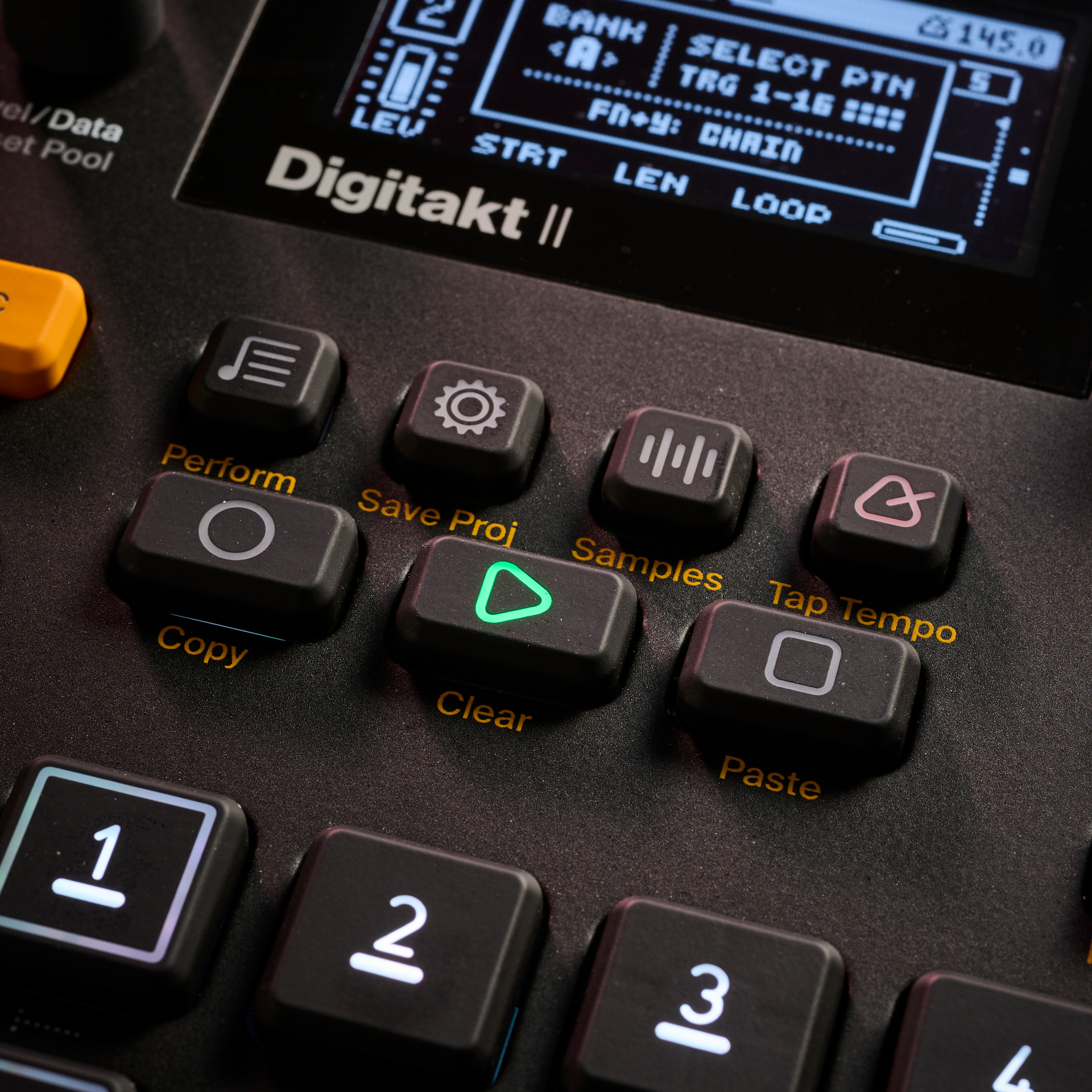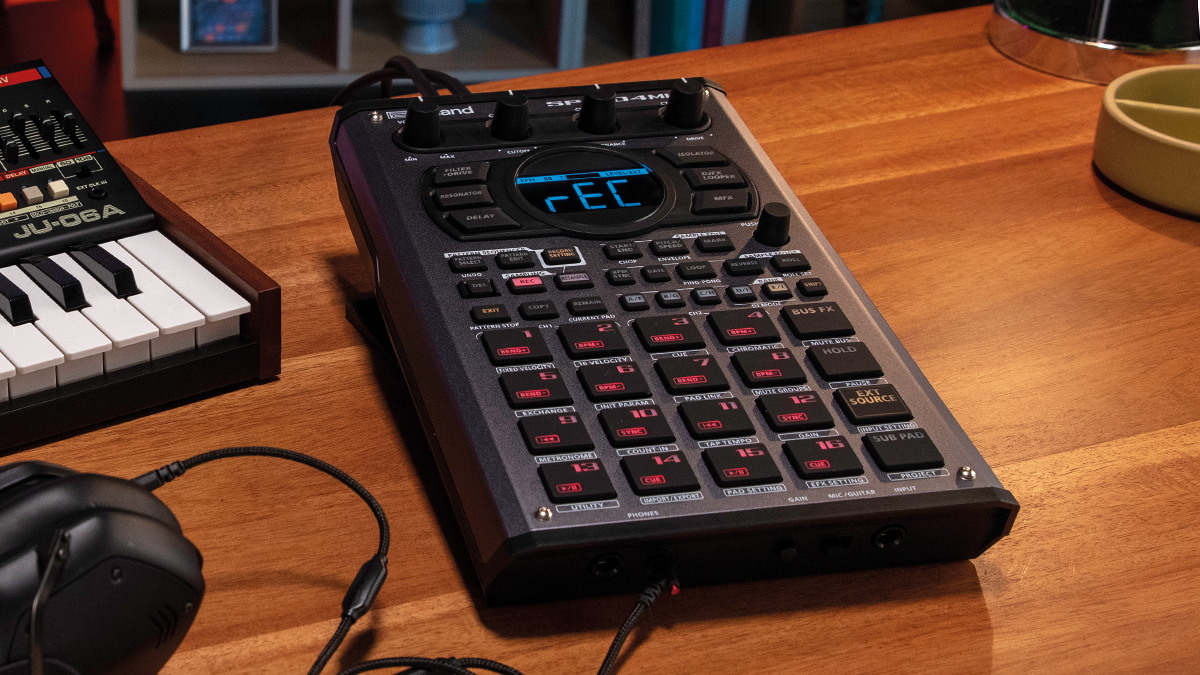MusicRadar Verdict
Those that got on well with the original Digitakt will love the extra tools and flexibility, but naysayers may remain unconvinced.
Pros
- +
Massively enhanced audio capabilities and onboard memory.
- +
Additional filters and LFOs significantly expand the capabilities.
- +
Euclidean sequencer is a great fit.
- +
Existing MIDI capabilities mean that Digitakt remains an excellent tool for driving external gear.
Cons
- -
Workflow can still feel convoluted.
MusicRadar's got your back
Elektron Digitakt II: What is it?
Released in 2017, Elektron’s original Digitakt was an influential release not just for the Swedish brand itself, but the wider hardware market. Having spent the previous decade focused on its top-end Analog range, the sub-$/£1k Digitakt, though hardly a budget instrument, saw Elektron bringing its distinctive designs back to the masses.
There’s no doubt those designs have influenced other gear that has followed it too – Elektron itself has replicated the format with its Digitone and Syntakt synths, and a number of Digitakt’s distinctive features have been widely adopted as standard across the industry too, including probability sequencing and parameter lock automation.
Described as a ‘drum computer and sampler’, Digitakt sits in a realm somewhere between a drum machine and a traditional sampler while – for reasons both for the better and worse, which we’ll come to – not quite fitting neatly into either category.
Earlier this year, Elektron lifted the lid on a direct sequel that significantly upgrades the design of the original without making any radical changes to the overall formula. Those upgrades include doubling the audio track count of the original from eight to 16. What’s more, each of these tracks is now capable of stereo playback, in contrast to the mono sampling of the original. Digitakt II also increases the modulation, filtering and effect options, as well as upgrading the capabilities of the sequencer.

Elektron Digitakt II: Performance and verdict
Let’s get the top level stuff out of the way first – Digitakt II is an all-round upgrade to the formula of the original, but it’s unlikely to convince any sceptics. While there are some significant improvements added for version II, nothing about this revamp fundamentally changes the Digitakt workflow, for better or worse.
The additional audio capabilities are the most immediately obvious enhancement. While you could certainly create fleshed-out compositions on the original machine, the additional audio tracks and incorporation of stereo source material – shown off nicely by the included presets – mean that it’s far easier to create near-finished sounding compositions.

• Roland SP-404 Mk II
Another popular sampler that's now on its Mk II iteration. Roland's SP-404 is better for sample slicing, and comes in at a cheaper price.
• Teenage Engineering EP-133 KO II
Teenage Engineering's beefed-up Pocket Operator is fun, with a fast sampling workflow, but lacks Digitakt's depth.
• Elektron Syntakt
Like the idea of Digitakt as a drum machine, but not bothered by sampling? Its synth-focussed sibling might tick all your boxes.
This is assisted in no small part by the vastly improved storage capacity for Digitakt II. This ups the original’s somewhat meagre 1GB of sample storage to 20GB, and ups the RAM from 64MB to 400MB. As a result, the amount of samples that can be loaded to a particular project rises from 128 to 1016.
Want all the hottest music and gear news, reviews, deals, features and more, direct to your inbox? Sign up here.
Each of its tracks can also be switched to act as a MIDI sequencer, meaning that, as before, Digitakt remains an excellent hub for a wider hardware setup.
The updated filters are excellent too. Whereas the original Digitakt had a resonant multimode filter and bi-directional Base filter for each audio track, this new version has the ability to alter the filter in that first slot. Alongside the existing filter model from Digitakt Mk I – here renamed Legacy – and parametric EQ, each track can now also make use of either a new multimode filter that can be swept or modulated through low-, band- and high-pass states, a more aggressive 4-pole low-pass filter, or a comb filter.
All of these new options are very welcome, but the comb filter in particular really adds to the flexibility of Digitakt’s sound engine, capable of bringing harsher and more synthetic qualities to the source samples.
These new filters work excellently alongside the sampler’s other major new feature – its expanded modulation capabilities. The headline addition here is that of an additional LFO per-track.
The implementation of flexible LFOs within Elektron’s instruments has long been one of our favourite aspects of their design. The setup is both flexible – capable of a variety of sync and shape options with controls for fades and retriggers – and easy to assign. As a result it’s easy to create patterns that are full of movement and life even before turning to the automation capabilities of the sequencer.
Having an extra modulator available for each audio track only enhances this, and given how much fun it can be to sweep the new multimode filter or slowly modulate the resonance of the comb filter, it’s an extremely welcome addition.

Digitakt II benefits from enhanced effects too, with a chorus added to the send effects – joining reverb and delay, along with a master compressor – as a whole new per-track effects page. This offers three types of digital distortion: Overdrive, which was also available on Digitakt Mk I, now joined by bit reduction and sample rate reduction, the latter of which can be configured to sit pre- or post-filter.
In sequence
Elektron’s sequencers have long been one of the most appealing elements of its instrument designs, despite hardly being what we’d call intuitive. Between conditional triggers, fills, parameter locks, micro-timings and much more, Digitakt’s sequencer will have newcomers regularly reaching for the manual, although you’ll always come away pleasantly surprised at just how flexible the whole setup is.
There’s nothing here that we’d describe as a radical overhaul to the sequencer, although there are a few significant upgrades. First and foremost, the maximum step length of patterns has been raised from 64 to 128, allowing for the creation of longer compositions without the need to chain two patterns together.
Digitakt II also gains a new Euclidean sequencer mode. This works by using two pulse generators to create evenly spaced patterns of triggers across a user-defined step length, and then uses a Boolean operator system to dictate how these two sets of pulses interact. It adds a nicely Eurorack-inspired touch of rhythmic creativity to the overall capabilities, which suits Digitakt well.
These are the topline changes, but there are a multitude of smaller tweaks throughout the OS too. One easily missed change that we’re particularly keen on is the increased flexibility in the way Digitakt routes audio over USB.

All of which adds up to a whole lot more depth, really doubling down on the things Digitakt was already capable of. There are also, however, areas where little has changed from the Mk I, and it’s these that may prove a continued sticking point for those that weren’t won over by the original.
For one thing, Elektron machines can be notorious for how convoluted their operating systems are and how much menu diving can be involved in the creative flow. Digitakt II does nothing to address this, adding more menu screens, rather than simplifying anything. We’ve long felt that the combination of +Drive, Projects, Sample Pools, Songs and Patterns feels like it adds too many layers of complexity to the overall architecture – although we’ll concede it’s very flexible.
Following a six month delay – the result, Elektron says, of having to write a whole new audio engine to cope with Digitakt II's capabilities – Overbridge functionality has finally arrived in a new OS update. But what does that actually mean?
Overbridge is Elektron's software application that allows its hardware instruments to function as a plugin in your DAW of choice. Not only does this allow for full software control, automation and recall of all parameters, but also lets each instrument stream multi-channel audio directly in and out of the DAW without needing to be used as an audio interface.
This functionality goes a long way to make up for the lack of individual analogue outputs for each track – something even more prominent now the track count has risen to 16.
Digitakt II also supports audio over USB and MIDI USB capabilities.
Significantly, aside from the stereo capabilities, nothing much has changed in regards to how Digitakt plays back the samples themselves. As before, Digitakt makes use of four playback ‘machines’ – added in a firmware update during the Mk I's life cycle – labelled One Shot, Werp, Repitch and Slice. Respectively, these will either play a sample back in a linear manner, warp the sample to fit project tempo, repitch a sample to fit project tempo, or slice a sample into segments that can be triggered individually.

Verdict
To expect Digitakt to be a do-everything sampler misses the point somewhat though. It’s the specific functionality of Digitakt that makes it an appealing and inspiring device, and that comes from the confluence of complex sequencing and its characteristic, if in some ways limited, sample engines.
Which brings us back to our earlier point of Digitakt fitting somewhere between the realms of drum machine and sampler. If you try to use it purely as either one of these things, you’re liable to wind up disappointed. Those looking for the immediacy of a hardware drum machine will likely be put off by its complex and unintuitive workflow, while those who want flexible sampling will butt up against some of its limitations. It’s in the space between these two realms where you find Elektron’s most unique ideas and where Digitakt II shines.
To put it simply, if you were already sold on the original Digitakt, this offers more of the same, with considerably more depth and power. While it’s not quite as cheap as it once was, the bump in price feels reasonable given the additional audio capabilities. Those that were unconvinced by the original, however, are unlikely to have their minds changed by this upgrade – as impressive as it is.
MusicRadar verdict: Those that got on well with the original Digitakt will love the extra tools and flexibility, but naysayers may remain unconvinced.
Elektron Digitakt II: Hands-on demos
Bo Beats

Loopop

AudioPilz
Elektron Digitakt II: Specifications
- KEY FEATURES: 16 × stereo or mono audio tracks, or MIDI tracks. 1 × digital base-width filter per track. 1 × digital overdrive per track. 1 × digital bit reduction. 1 × digital sample rate reduction. 1 × overdrive master effect . 1 × stereo compressor master effect. 3 × assignable LFOs per track. 400 MB sample memory. 20 GB +Drive storage.
- CONTACT: Elektron
I'm the Managing Editor of Music Technology at MusicRadar and former Editor-in-Chief of Future Music, Computer Music and Electronic Musician. I've been messing around with music tech in various forms for over two decades. I've also spent the last 10 years forgetting how to play guitar. Find me in the chillout room at raves complaining that it's past my bedtime.

